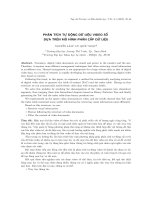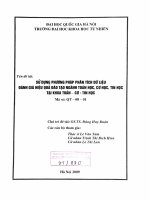Phân tích dữ liệu EEG sử dụng Empirical modal Decomposition
Bạn đang xem bản rút gọn của tài liệu. Xem và tải ngay bản đầy đủ của tài liệu tại đây (2.72 MB, 72 trang )
VIETNAM NATIONAL UNIVERSITY HANOI
UNIVERSITY OF ENGINEERING AND TECHNOLOGY
EEG DATA ANALYSIS USING EMPIRICAL
MODAL DECOMPOSITION
Phạm Văn Thành
BACHELOR THESIS
May, 2012
EEG DATA ANALYSIS USING EMPIRICAL
MODAL DECOMPOSITION
Phạm văn Thành
Faculty of Electronics and Telecommunications
University of Engineering and Technology
Vietnam National University, Hanoi
Supervised:
Dr. Nguyễn Linh Trung
Document submitted for committee examination as a requirement for
the Bachelor of Electronics and Communications Engineering degree
at the University of Engineering and Technology
May, 2012
AUTHORSHIP
“I hereby declare that the work contained in this thesis is of my own and has not been
previously submitted for a degree or diploma at this or any other higher education
institution. To the best of my knowledge and belief, the thesis contains no materials
previously published or written by another person except where due reference or
acknowledgement is made.”
Signature:………………………………………….
i
SUPERVISOR’S APPROVAL
“I hereby approve that the thesis in its current form is ready for committee
examination as a requirement for the Bachelor of Electronics and Communications
Engineering degree at the University of Engineering and Technology.”
Signature:………………………………………………
ii
TABLE OF CONTENTS
INTRODUCTION .........................................................................................................1
BACKGROUND ............................................................................................................4
2.1. Time-Frequency Presentation ................................................................................5
2.1.1. Signals in classical representation ..................................................................5
2.1.2. The need for Time-frequency representation ...................................................5
2.1.3. The techniques for Time-Frequency Presentation ............................................5
2.1.3.1. The Wigner-Ville Distribution...................................................................6
2.1.3.2. The Spectrogram ......................................................................................6
2.1.3.3. The Reassigned spectrogram ....................................................................7
2.1.3.4. Drawbacks of Wigner-Ville and Spectrogram methods .............................8
2.2. EEG Signal Characteristics....................................................................................9
2.2.1. The Nervous System ........................................................................................9
2.2.1.1. Neurons ..................................................................................................10
2.2.1.2. The Cerebral Cortex ...............................................................................11
2.2.2. Electrical Activity Measured on the Scalp .....................................................12
2.2.3. Normal EEG .................................................................................................13
2.2.4. Spikes in the EEG Signals .............................................................................14
2.2.5. EOG in the EEG Signals ...............................................................................15
2.2.6. EEG Artifacts................................................................................................15
2.3. Empirical Mode Decomposition ..........................................................................15
2.3.1. The sifting process ........................................................................................19
EEG DATA ANALYSIS USING EMPIRICAL MODE DECOMPOSITION .........21
3.1. The method for measure real data ........................................................................22
3.1.1. Devices connection .......................................................................................23
3.1.1.1. Connect the electrodes to an amplifier ....................................................23
3.1.2. Attach the electrodes to the patient................................................................23
3.1.2.1. The electrodes on the cap .......................................................................23
iii
3.1.2.2. The outside electrodes: ...........................................................................24
3.1.3. Choose the parameters on the machine .........................................................25
3.1.4. Surrounding environment ..............................................................................25
3.1.5. Measurement ................................................................................................26
3.1.5.1. Check the impedance of the electrodes ....................................................26
3.1.5.2. Standard (calibration) ............................................................................26
3.1.5.3. Record ....................................................................................................26
3.1.5.4. Observe the patient .................................................................................27
3.1.5.5. Stimulation .............................................................................................27
3.1.6. Data assessment............................................................................................28
3.2. Applying EMD into EEG signals processing .......................................................31
RESULTS AND DISCUSSIONS ................................................................................35
4.1. Results ................................................................................................................36
4.1.1. Model for Simulation ....................................................................................36
4.2. Discussion ...........................................................................................................46
CONCLUSIONS ..........................................................................................................50
References ....................................................................................................................53
Appendix A ..................................................................................................................55
iv
Abstract
Epilepsy is one of the most popular neurological disorders characterized
and unexpected electrical disturbances of the brain. The electroencephalogram
(EEG) is an invaluable measurement for the purpose of assessing brain
activities, containing information relating to the different physiological states
of the brain. It is a very effective tool for understanding the complex dynamical
behavior of the brain. This thesis presents the application of Empirical Mode
Decomposition (EMD) for analysis EEG signals. EMD is a technique, it can be
compared with other analysis methods like Fourier Transforms and wavelet
decomposition. It is a method of breaking down a signal into IMFs without
leaving the time domain. It is useful for analyzing natural signals using the way
to filters out functions which form a complete and nearly orthogonal basis for
the original signal. As we know, the EEG is a very complex signals, it contains
many elements such as: background, EOG, EMG, spikes… So, the EMD
decomposes the EEG signal into a finite set of bandlimited signals named
Intrinsic Mode Functions. After that, using Reassigned-Spectrogram to present
the EEG signal together with IMFs on Time-Frequency domain and using
Hillbert transformation for presents IMFs on the complex plane. The area
measured from the trace of the analytic IMFs, which have circular form in the
complex plane, has been used as a feature in order to distinguish the
background, EOG and spikes in epileptic EEG signals. It has been shown that
the area measure of the IMFs on the complex plane has given good
discrimination performance between background, EOG and spikes.
v
Acknowledgement
I would like to express my sincere thanks to my advisor Dr. Nguyen
Linh Trung, the professional of Faculty of Electronic and Communication,
University of Engineering and Technology – Vietnam National University,
Hanoi for the guidance and support given to me throughout the thesis.
Special thanks to Dr. Tran Duc Tan and Ms. Nguyen Thi Thuy Duong
the lecturers of Faculty of Electronic and Communication for their help and
guidance me in all thesis process.
I would like to thank doctor. Hoang Cam Tu who help me to use,
measure the EEG machine system and the method to detect spikes and read
noise.
Thanks for all of people in the Signal Processing Lab for their help and
discussed conversations.
At the end, I would like to thank my parents and my brother because
their comfort and supporting are the power for me going to success.
vi
List of Figures
Figure 2-1: Example with a 128 point 2-component signals different TFDs are display
in the case of 128 point. ............................................................................................. 8
Figure 2-2: A signal propagating down an axon to the cell body and dendrites of the
next cell [11]. .......................................................................................................... 10
Figure 2-3: Three types of neurons. Motor, sensory, and interneurons [12]. ............ 11
Figure 2-4: Corebral cortex and four lobes [13]. ...................................................... 12
Figure 2-5: EEG signal in the different status was excited, relaxed, drowsy, asleep,
and deep sleep ......................................................................................................... 14
Figure 2-7: Empirical Mode Decomposition (EMD) of a three component signal .... 17
Figure 2-8: Illustration of the process of EMD technique breakdown signal into IMFs
components [15]. ..................................................................................................... 19
Figure 3-1: International standard 10/20 .................................................................. 22
Figure 3-2: The connection between electrodes with an amplifier ............................ 23
Figure 3-3: EOG attached ........................................................................................ 24
Figure 3-4: EMG attached Figure ............................................................................ 25
Figure 3-5: Unipolar ............................................................................................... 27
Figure 3-6: Bipolar ................................................................................................. 27
Figure 3-7: The raw EEG Signal .............................................................................. 29
Figure 3-8: EEG Signals before use filters ............................................................... 30
Figure 3-9: EEG Signals after use filters .................................................................. 31
Figure 3-10: analytic signal representations in the complex plane (window size = 512
samples.................................................................................................................... 33
Figure 4-1: The Empirical Mode Decomposition of (a) background, (b) spikes, (c)
EOG ........................................................................................................................ 39
Figure 4-2: EEG Signals and IMFs ((a) background, (b) spikes, (c) EOG)on TimeFrequency domain of Reassigned-Spectrogram method ........................................... 42
vii
Figure 4-3: analytic signal representations in the complex plane (window size = 512
samples) .................................................................................................................. 44
Figure 4-4: The difference between background, spikes and EOG base on energy level
and frequency level.................................................................................................. 46
Figure 4-5: background signal and IMFs .................................................................. 48
viii
List of Tables
Table 2-1. The comparision of three type of Time-Frequency Distribution (WignerVille Distribution, Spectrogram and Reassigned-Spectrogram). ................................. 9
Table 4-1: Model for simulation .............................................................................. 37
Table 4-2: Area of analytic signal representation of Intrinsic mode functions........... 45
ix
List of Abbreviations
CNS
Central Nervous System
CTM
Central Tendency Measurement
EEG
Electroencephalograph
EMD
Empirical Mode Decomposition
EOG
Electrooculogram
FFT
Fast Fourier Transform
HHT
Hilbert-Huang Transform
IMFs
Intrinsic Mode Functions
PNS
peripheral Nervous System
RSP
Reassigned-Spectrogram
SP
Spectrogram
STFT
Short Time Fourier Transform
TFD
Time-Frequency Distribution
TF
Time-Frequency
WVD
Wigner-Ville Distribution
x
Chapter 1
INTRODUCTION
1
Epilepsy is a pathological status of the brain, it occurs by many different
causes and it is complex and diverse, can be found in every age, every
gender. According to the World Health Organization (WHO), the number of
people catches epilepsy in the earth accounts for 0.5% of the population. With
adults, epilepsy affects about 1% of the population and this rate is increasing
when the aging population is more and more popular. In Vietnam, it is about
2% and most of them are children. Most of epilepsy diagnosis is based on
primarily clinical methods, such as the identification of signs or symptoms of
clinical seizures. An Electroencephalograph (EEG) records the brain's activity;
EEG is the most complementary test for clinical diagnosis. Especially, it is able
to identify types of epilepsy and brain lesion areas which caused epilepsy
impulses.
At the moment, in Vietnam as many other countries, the EEG recording
system are in very common, use the signals of these machines appear on the
computer screen or paper and the way to detect epilepsy spikes belong to the
visual eyes of the doctors because the epilepsy pulses are different from
background signals. Nevertheless, in the measurement process, apart from the
brain activity a various other tapes of activity occur: eye movement, muscle
movement, heart beating, light…These are called artifacts and can make
changs in the amplitude and frequency of the signals. As a result, they can
make to difficult to interpret the EEG signals or lead to wrong diagnosis.
In order to reduce the wrong diagnosis, we need methods which can
detect the artifact. Based on that, doctors can find out epilepsy pulses easier.
So, this thesis, focuses on the Empirical Mode Decomposition (EMD)
technique to decompose EEG signals into Intrinsic Mode Functions (IMFs).
From these IMFs, Central Tendency Measure (CTM) to detect which artifacts
are exits in the EEG signals.
The purpose of this thesis is to measure and investigate the characteristic
of EEG signal and distinguishes EOG, spikes and background of epileptic EEG
signals using Time-Frequency toolbox, EMD technique and CMT method.
The thesis is organized as follow. Chapter 2 introduces the necessary
background. Chapter 3 gives information of the process to measure data and
2
decentes in detail the EMD in EEG signal processing. Chapter 4 shows
simulation and discussion. Chapters 5 concludes the thesis and propose some
related for future works.
3
Chapter 2
BACKGROUND
4
2.1. Time-Frequency Presentation
2.1.1. Signals in classical representation
In signal processing, time domain and frequency domain are two basic
representations of a signal. Time domain representation shows how a signal
changes over time. Frequency domain representation shows how the signal
changes over a range of frequencies.
Time description of signals: Signals can be described in the time
domain ( ), for the case of continuous time, or at various separate instants in
the case of discrete time.
Frequency description of signals: frequency domain ( ) used to
describe the domain for analysis of mathematical functions or signals with
respect to frequency, rather than time. Any practical signal
represented in the frequency domain by its Fourier transform
( )= Ƒ
→
{ ( )} =
( ) can be
( ):
( )
2.1.2. The need for Time-frequency representation
In both forms of representations described above, the variables time and
frequency are treated as mutually exclusive, that means to obtain a
representation of signal in terms of one variable, and the other variable is
ignored. Consequently, the frequency representation is averaged over the
values of the time representation at all times, and the time representation is
averaged over the values of the frequency representation at all frequencies. In
the time-frequency distribution, denoted by ( , ), the variables and are
not mutually exclusive, but are present together.
In this report we are using the Wigner-Ville Distribution (WVD), the
Reassigned Spectrogram (RSP) and the Spectrogram. In the following part, we
will consider these three Time-Frequency Distribution methods.
2.1.3. The techniques for Time-Frequency Presentation
There are a lot of Time-Frequency Presentation methods such as: Gabor
transforms, wavelet, Wigner distribution function, Gabor-Wigner distribution
5
function. Nevertheless, in this thesis, I only mentioned to three main methods
are: Wigner-Ville Distribution, Spectrogram and Reassigned Spectrogram.
2.1.3.1. The Wigner-Ville Distribution
The Wigner-Ville distribution (WVD) of a signal s(t), denoted by
( , )= Ғ
→
{ ( + ) ∗( − )}
2
2
Where z(t) is the analytic associate of s(t).
In the case of a single component, it is well-known that a perfect
localization can be attained for pure a linear FM with the instantaneous
frequency of the form f(t) = fᴏ + αt by using the Wigner-Ville Distribution:
∞
( , )=
+
∝
∗
( − )
2
2
Although this property can be extended to some forms of nonlinear
FMs, it is generally at expense of a substantially increased complexity in the
definition of the distributions, with furthermore the limitation of being adapted
to some specific type of FM only and to not extend to multicomponent
situations. For this last point, the well-known drawback of energy distributions
is to obey a quadratic superposition principle which creates cross-terms in
between two components of a signal, and thus significantly reduces the
readability of Wigner-Ville distributions.
2.1.3.2. The Spectrogram
The Short Time Fourier Transform (STFT) can be interpret as a Fourier
analysis of successive sections of the signal weighted by a temporal window
such as Gabor, Hamming and Blackman. The STFT is given by:
( )ℎ∗,
( , )=
( )ℎ∗( − )
=
This relation represents the scalar product between the signal
the functions ℎ
window ℎ
,
( ) and
( ). In practice, the spectrogram corresponding to the
,
( ) is given by:
( , )⃒
( , ) = ⃒
Where
∗
( ) is the complex conjugate of
( ) and ℎ( ) is an analysis
window. The spectrogram can be seen as a smoothed version of the WignerVille distribution of the signal
( ) is shown as follow:
6
( , )=
( , )
( − , − )
2
The advantage of this method is that it free from cross-terms, by
( ).
definition, it is a linear fuvetion of
2.1.3.3. The Reassigned spectrogram
The method of reassignment is a technique for sharpening a timefrequency representation by mapping the data to time-frequency coordinates
that are nearer to the true region of support of the analyzed signal. In the case
of the spectrogram, the method of reassignment sharpens blurry time-frequency
data by relocating the data according to local estimates of instantaneous
frequency and group delay.
The spectrogram, which is the squared modulus of the short-time
Fourier transform, can also be written as a two-dimensional smoothing of the
Wigner-Ville distribution:
( , )=
( , )
( − , − )
At each time-frequency point ( , ) where a spectrogram value is
computed, we also compute the coordinates ( ̂ , ) of the local centroid of the
Wigner-Ville distribution
, as seen through the time-frequency window
centered at ( , ):
( , )=
( , )=
1
=
( , )
1
=
( , )
Then, the spectrogram value
( , )
( − , − )
( , )
( − , − )
( , )is moved from ( , ) to ( ̂ , ). This
leads us to define the reassigned spectrogram as:
̌ ( , )=
( , ) ( − ̂ ( , )) ( −
7
( , ))
(a)
(b)
(c)
(d)
Figure 2-1: Example with a 128 point 2-component signals different TFDs are
display in the case of 128 point signal whose TF model is given in the bottom row left,
the Wigner-Ville Distribution in the left top row, the reassigned spectrogram in the
right top row, and ideal distribution in the right in the bottom left, the spectrogram in
the bottom right.
2.1.3.4. Drawbacks of Wigner-Ville and Spectrogram methods
Wigner-Ville distribution: Cross-term can make difficultly to interpret,
especially if the components are numerous or close to each other, and the more
so in the presence of noise; cross-terms between signal components and noise
exaggerate the effects of noise and cause rapid degradation of performance as
the SNR decreases.
Spectrogram: Cross-term is lower; it makes easily to interpret, but a
poorer localization.
In conclusion, the Reassigned spectrogram distribution is the best
method for time-frequency distribution because Reassigned Spectrogram
8
method can avoids cross-term while the localization is not decrease. So I have
built a table for the comparison of some Time–Frequency Distribution above:
Table 2-1. The comparision of three type of Time-Frequency Distribution
(Wigner-Ville Distribution, Spectrogram and Reassigned-Spectrogram).
Methods
Clarity
Localization Crossterm
Computational
complexity
Wigner-Ville
Low
High
High
Low
Spectrogram
Medium
Low
Low
Low
ReassignedSpectrogram
High
High
Low
High
Distribution
2.2. EEG Signal Characteristics
The human brain has complex structure, it includes millions of neurons
and each neuron generates a small of electric voltage fields. The aggregate of
these electric voltage fields will make enough amount of electrical for
electrodes on the scalp can access and record. Therefore, the EEG signal is a
complex of many simple signals. The amplitude of EEG signal fluctuated from
1µV to 100µV with a normal adult.
2.2.1. The Nervous System
A nervous system includes gathering, communicates and processing
information from various part of the body. There are two types of nervous
system:
Central Nervous System (CNS)
Peripheral Nervous System (PNS)
In that, central nervous system consists the brain and the spinal cord and
peripheral nervous system has function to connect between the central nervous
system with the body organs and sensory systems.
Besides, the nervous system also have divided into two difference kind
of system are somatic and autonomic based on its functionality. The somatic
nervous system contains nerves which control muscle activity in response to
9
conscious commands and the autonomic nervous system consists nerves which
control the cardiac activity and muscle activity in internal organs such as
bladder and uterus.
2.2.1.1. Neurons
Neuron is a cell specialized in order to conduct electrical impulses and it
is the basic functional unit of nervous system which can communicate
information with the brain.
Figure 2-2: A signal propagating down an axon to the cell body and dendrites
of the next cell [11].
There are three major classes of neurons:
10
Figure 2-3: Three types of neurons. Motor, sensory, and interneurons [12].
Sensory neurons: connected to sensory receptors
Inter-neurons: connected to muscles
Motor neurons: connected to other neurons
2.2.1.2. The Cerebral Cortex
The cerebral cortex is the most important part of the central nervous
system. The different areas of cortex have different functions such as:
sensation, studying, emotion…The cortex includes two parts: The right and the
left symmetrical hemispheres and each hemisphere is separated into four lobes:
frontal, temporal, parietal, and occipital.
11
Figure 2-4: Corebral cortex and four lobes [13].
2.2.2. Electrical Activity Measured on the Scalp
The collective activity electrical of the cerebral cortex is usually referred
to as a rhythm because when we measured the signals often exhibit oscillatory
and repetitive behavior. The activity of a single neuron cannot measure on the
scalp because the amount of electrical impulse is too small, but when we
combined millions of neurons together, it can measure very easy on the scalp.
The EEG signal rhythms is very enormous, it depends on the
environment around people and state of them such as: temperature, light or
waking or sleeping. The rhythms are conventionally characterized by their
frequency range and relative amplitude.
The amplitude of the EEG signal is related to the degree of synchrony
with which the cortical neurons interact. Synchronous excitation of a group of
neurons procedures a large-amplitude signals on the scalp because the signals
originating from individual neurons will add up in a time-coherent fashion.
Repetition of the synchronous excitation results in a rhythmic EEG signal,
consisting of large-amplitude waveforms occurring at a certain repetition rate.
The frequency or the oscillatory rate of an EEG rhythm is partially
sustained by input activity from the thalamus. This part of the brain consists of
neurons which possess pacemaker properties. They have the intrinsic ability to
generate a self-sustained, rhythmic firing pattern. Another reason to the
rhythmic behavior is coordinate interactions arising between cortical neurons
themselves in a specific region of the cortex. In the latter case, no pacemaker
12
function is involved, but the rhythm is rather an expression of a feedback
mechanism that may occur in a neuronal circuit.
High frequency/low amplitude rhythms reflect an active brain associated
with alertness or dream sleep, while low frequency/large amplitude rhythms are
associated with drowsiness and non-dreaming sleep states.
2.2.3. Normal EEG
EEG is generally described in terms of its frequency band. Delta, theta,
alpha, beta and gamma are the names of the different EEG frequency bands
which relate to various brain states.
Delta waves, 0.1 to 3 Hz. The delta waves are typically encountered
during the deep, dreamless sleep, non-REM sleep, unconscious and it
has large amplitude. So, it usually is not observed in the awaking
status.
Theta waves, 4 – 7 Hz. The theta waves appear during drowsiness and
in certain stages of sleep.
Alpha waves, 8 – 12 Hz. The alpha waves is the most prominent in
normal subjects who are relaxed, but not drowsy, tranquil, conscious,
awake with eyes closed; the activity is suppressed when the eyes are
open. The amplitude of the alpha waves are the largest in occipital
regions.
13









